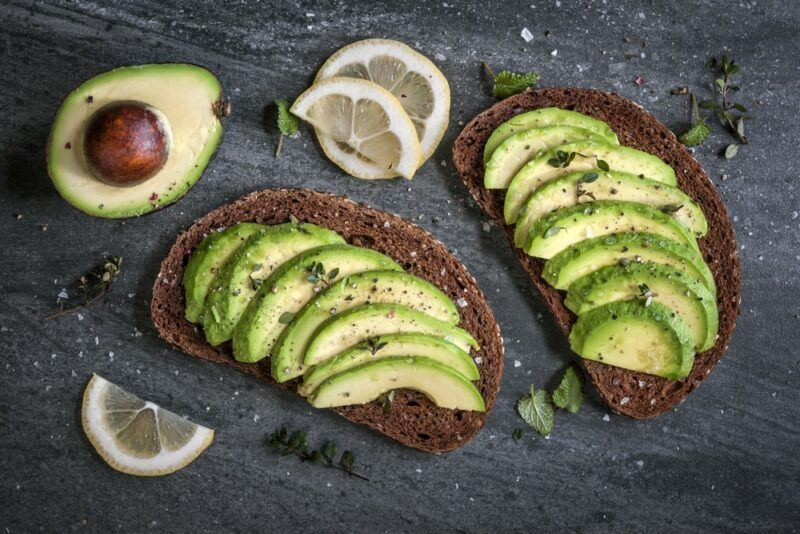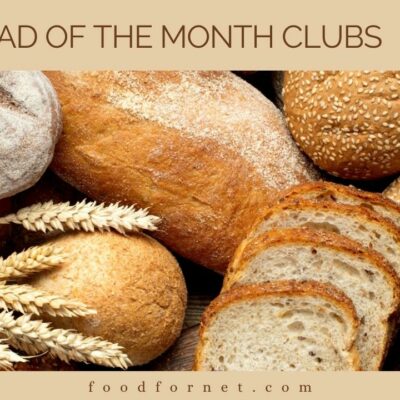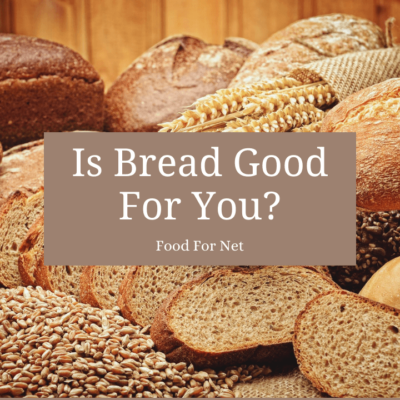
If you’re looking for healthy bread, rye might seem like an obvious choice. It’s much darker than regular bread with a distinct flavor, which makes it seem much healthier and less refined than white bread. You might even assume that rye bread relies on whole grains. Still, we have to ask, is rye bread good for you?
To begin with, let’s talk a little about rye itself. Rye itself is a type of grass that’s grown and used as a grain. It has a variety of uses, including being used to create rye whiskey, some beer, and even rye vodka.
Rye has been used as an ingredient since at least the Middle Ages and possibly much much earlier. The grain isn’t incredibly popular these days, paling in comparison to other options, like wheat. Still, none of this stops rye from being important.
Indeed, rye has some benefits over wheat, including the fact that it contains less gluten. Rye bread also simply makes a nice change, one that many people love the flavor of. Rye bread can also be frozen just as easily as other types of bread.
Is Rye Bread Good For You?
- Types Of Rye Bread
- Is Rye Bread Gluten Free?
- Benefits Of Rye Bread
- The Problems With Rye Bread
- Are Grains Unhealthy?
- Final Thoughts
Types Of Rye Bread

Not surprisingly, rye bread is made from rye flour. It tends to have a darker color than regular wheat bread, along with an earthy flavor. While this flavor doesn’t appeal to everyone, many people love it and choose rye bread for this reason.
However, rye bread isn’t all the same. The biggest difference comes from the balance of rye flour to rye grains.
Light rye bread relies on white rye flour. This is created from rye endosperm, making it similar to white wheat flour. The approach gives the bread a lighter color and flavor, but does mean that there are fewer nutrients present.
Then there’s dark rye bread. This version generally relies on flour made from whole rye grains. The approach gives the bread a darker color and a more intense flavor.
You may see marbled rye bread too. Here, the bread is made using two types of dough, a light rye dough and a dark rye one. The approach makes the bread look much more interesting, while also providing some variation in flavor.
Pumpernickel bread is slightly different. It’s still a type of rye bread, but it’s made using coarsely ground rye and a sourdough starter. This gives it some of the properties of sourdough bread, along with the flavor of light rye bread.
You might also run into a few unexpected ingredients.
For example, many commercially produced rye breads in the United States use wheat flour as one of their main ingredients. Sometimes there’s even more wheat present than rye. Rye bread that heavily relies on wheat flour isn’t going to have all the same benefits as bread that’s just made with rye.
There may be additives in your bread to help stabilize it or change the flavor profile.
Is Rye Bread Gluten Free?
Even if you find rye bread with no wheat at all, you’re still not getting a gluten free product. Rye grains themselves do contain gluten, so gluten is found in rye bread as well.
However, rye does contain more soluble fiber and less gluten than wheat. The lower gluten content might make rye bread a better choice for anyone with a minor gluten sensitivity.
Benefits Of Rye Bread

Can Be Healthier Than White Bread
Rye grains are what make rye bread so interesting. Rye tends to contain less gluten than wheat and is a complete source of protein, providing all the acids that you need. In contrast, some amino acids in wheat are too low to provide complete nutrition.
Interestingly, rye is often higher in carbs than wheat, but tends to be higher in fiber as well. The high fiber content is particularly relevant for health.
There are also the nutrients to think about. Wheat does contain higher amounts of some vitamins and minerals compared to rye. However, rye has a broader array of vitamins and minerals, including vitamin E, vitamin A, and vitamin K.
Those differences refer to the grains themselves, but you’ll see similar patterns come through with wheat bread versus rye bread as well.
There are also a few benefits that have been linked specifically to rye bread, including the potential to protect against some types of cancer and to decrease inflammation. While much more research is needed, these possible benefits make rye bread even more interesting.
High In Fiber
Rye bread can be a decent source of fiber too, which helps with your digestion and overall health.
Indeed, rye bread might be even better at reducing constipation than laxatives and wheat bread. Rye bread also does so without unpleasant side effects (which is notable, as laxatives aren’t any fun at all).
To get the most fiber, you’ll need to stick to whole grain rye bread. The best products will focus on rye, rather than adding extra wheat flour and sugar for flavor.
It’s Versatile And Easy To Use

Much of bread’s popularity comes from how useful it is. Just think of how many times you rely on bread as part of your breakfast or as the base of your sandwiches at lunch time.
In fact, many of us buy or make at least one loaf of bread each week. It’s easy to see why too, as once the bread has been baked, it’s incredibly easy to use. Then there are creative things that you can make using bread, including rolls, bread pudding, and toasties.
Rye bread does have a stronger flavor than white bread, but this doesn’t make it any less useful. Indeed, you might even prefer the intensity of rye bread.
Rye Is An Ancient Grain
Modern grains, like wheat and rice, have been through a lot of change over time. They’ve often been hybridized and selectively bred to provide a nutritious product and high yield for farmers. Some are even genetically modified.
Ancient grains are different. They’ve been left relatively untouched throughout human history – making them perfect for anyone who focuses on natural foods as much as possible.
There’s also the chance that ancient grains are healthier than modern grains. If nothing else, they have different nutritional profiles, making grains like rye an interesting way to change up your diet and make it more interesting.
May Promote Weight Loss
While bread tends to be high in calories and carbs, it can also promote weight loss when used well. Some research even shows that wholegrain rye bread promotes decreased body weight and fat, while wholegrain wheat bread doesn’t have the same effect.
This isn’t so surprising, as rye bread is often high in soluble fiber. This type of fiber bulks up when it comes into contact with water, helping us to feel full for longer.
The trick is to choose your toppings well.
Bread isn’t that filling on its own and can spike your blood sugar levels. Topping rye bread with plenty of vegetables and some protein is an easy way to make it more satisfying.
The weight loss benefits come from fiber, so once again, whole grain rye bread is likely to be the best choice.
The Problems With Rye Bread

It’s High In Carbs
There’s no getting around it – rye bread is high in carbs. The carb content strongly depends on the product that you choose, but you’re often looking at 15 grams of carbs in a single slice, if not more.
Some of those carbs come from fiber, but most of them don’t. This means you’re getting a decent amount of digestible carbs in every slice of bread. In fact, most of the calories in rye bread come from carbs.
Is this a problem? Well, that depends on your point of view.
Carbs are an effective source of energy and are popular for that reason. However, you can also get energy from fat and protein, and those macronutrients don’t spike your blood sugar or promote inflammation in the same way as carbs.
There are also concerns that our modern diets rely far too much on carbs. This carb focus could even be the reason for how common diseases are these days.
Many people find it best to cut down their carb intake. Doing so might involve giving up rye bread entirely or perhaps just keeping your portion sizes low.
Contains Phytic Acid
Grains can be problematic too, as they contain compounds known as antinutrients. These can decrease the absorption of key nutrients, including iron and zinc.
Rye bread is particularly high in the antinutrient phytic acid.
If you’re getting plenty of nutrients in your diet and don’t have bread with every meal, then the phytic acid in rye bread may have a minimal effect. However, if your iron or zinc intake is already limited, then antinutrients may increase your risk of deficiency.
For most people, the best answer isn’t to stop eating bread, but to make sure that your nutrient intake is high. You could also try making a sourdough version of rye bread. This works well because the sourdough fermentation breaks down the phytic acid.
Still Contains Gluten
Gluten is significant because some people’s bodies develop an immune reaction to it, which damages the small intestine’s lining. The effect causes a range of symptoms and decreases nutrient absorption from food.
This means that people with celiac disease really do need to avoid gluten entirely. Gluten sensitivity causes similar symptoms without the intestinal harm, so many people still need to cut out gluten.
Rye bread contains less gluten than wheat bread, but you’re still getting a decent amount. So, if you have celiac disease or are highly sensitive to gluten, you might need to avoid the bread entirely.
Can Lead To Side Effects
Rye bread can lead to multiple side effects, including bloating and stomach cramps.
Some of these issues come from the fiber, so they’re particularly strong with whole grain rye bread. Such side effects are easily avoided by increasing your fiber intake slowly and drinking plenty of water.
The other issue is the gluten. Even if you don’t have celiac disease, you might still be sensitive to gluten, which could easily lead to side effects.
It’s Often Not A Wholegrain Product
Most of the discussed benefits are strongest in wholegrain rye bread.
However, the bread is often made using refined rye flour instead. This gives it many of the same problems that you find with white bread.
To avoid this issue, it’s important to focus on wholegrain rye products, ones that don’t use wheat flour as a filler. Be warned though, full rye bread takes a little getting used to, as it has a thick and almost sticky consistency, along with a distinctive flavor.
May Contain A Surprising Amount Of Sugar

Sugar is always concerning. Sure, it makes our food taste better, but it does so at a price, including increased inflammation, higher risk of some diseases, and weight gain.
Rye bread can be a problem here, as many companies add sugar into their recipes. While doing so offsets the intensity of the rye flavor, you’re often getting more sugar than you want or need.
The added sugar isn’t obvious either.
You easily pick up a loaf of rye bread and assume that it’s healthy, then find out that it doesn’t use whole grains, contains added sugar, and uses more wheat flour than rye flour. This is why it’s so important to closely check the nutritional labels.
Are Grains Unhealthy?
To talk seriously about rye bread, we also need to address a large ongoing debate – whether grains are unhealthy or not.
On the one hand, whole grains are often thought to promote health and may even decrease your risk of disease. This isn’t surprising either, given that whole grains offer plenty of fiber and nutrients.
On the other hand, even whole grains are high in carbs. While the fiber content reduces their blood sugar impact, there is still some effect on blood sugar. And, as we mentioned earlier, carbs themselves are thought to increase inflammation and promote disease.
Many people are concerned about other features of grains too, including antinutrients, which can decrease the absorption of some nutrients.
The jury is still out on the benefits versus risks of grains. Large studies do continue to show that regular whole grain consumption decreases the risk of type 2 diabetes and heart disease. However, those same benefits could be seen with different types of diets too, including low carb ones.
You’ll need to decide for yourself whether you want to eat grains or not.
Whole Grains Are Clearly The Winners
Most of the observed benefits of grains come from whole grains. These give you the most nutrients and are closer to their natural form.
One serious problem with bread, including rye bread, is that you’re often not looking at a wholegrain product. Some versions of rye bread are even made using some white flour. Others rely mostly on rye, but some parts of the grain have been stripped away.
There’s an additional problem too – bread is made by grinding grains to make flour. This process breaks down the grain and can damage the cell walls. Doing so influences how the grain is digested, giving it a faster impact on our blood sugar.
This means that even if you do find wholegrain rye bread, it won’t provide all the benefits that rye grains themselves offer.
Final Thoughts

Rye bread is often healthier than white bread, giving you more nutrients and fiber, while having a lower impact on your blood sugar.
Still, the specific product that you choose will have a huge impact, as some types of rye bread are more processed than others. Look for wholegrain products, ones that don’t use wheat flour as an ingredient and keep the sugar content low. These offer the most benefits and fewest risks.
At the end of the day, though, rye bread is still bread.
It has many of the familiar problems as white bread, including the carb content and the processing. There are also plenty of healthier foods, ones that give you more nutrients.
What this means is up to you.
Some people choose to skip bread entirely, while others look for the healthiest versions they can find. You can also simply make sure that you choose good ingredients to serve with your bread.
For example, a rye bread sandwich with lean protein and plenty of vegetables should give you a filling and nutrient-packed meal. Doing so would keep you going for much longer than jelly on toast.
Frequently Asked Questions
Does Rye Bread Have Wheat?
Despite relying on rye flour, many rye bread products also contain a decent amount of wheat flour. This is particularly true for the mass produced rye bread that you often see in grocery stores.
Is Rye Bread Good For Diabetics?
Some types of rye bread can be helpful for diabetics, especially as whole grains provide many long-term benefits. Look for products that focus on whole grain rye flour, as these should contain the most fiber and have the lowest GI.
It’s also important to watch your serving size, as whole grains can still spike blood sugar. Try having some source of protein or fat on the bread to help balance the carbs.
Is Rye Bread Vegan Friendly?
Most rye breads will be vegan friendly, as the basic bread ingredients are vegan, as are rye grains themselves. It’s still important to check the ingredients list though, as a few products may use non-vegan additives.
Is Rye Bread Good For Weight Loss?
Despite having a poor reputation, bread can be relevant when you’re trying to lose weight. In particular, it acts as a fantastic vehicle for many nutritious ingredients, including salad vegetables and lean protein.
To lose weight with rye bread, you need to pay attention to the balance of bread to other ingredients. This could involve making an open faced sandwich (which uses one slice of bread instead of two), then stacking this with plenty of vegetables.
Is Rye Bread Keto?
No. Rye bread contains just as many carbs as regular bread, which makes it a poor choice for keto. Keto dieters will need to stick to low carb bread recipes instead. These normally avoid grains and use ingredients like coconut flour instead.










 15 Best Vegetables to Can with Canning Tips for Beginners
15 Best Vegetables to Can with Canning Tips for Beginners
Leave a Reply